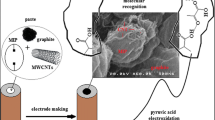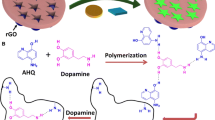Abstract
Nano-sized molecularly imprinted polymers (nano-MIPs) possessing cavities that fit nicotinic acid were synthesized via precipitation polymerization. Acrylamide, divinyl benzene, nicotinic acid (NA) and acetone were utilized as functional monomer, cross-linker, template and porogen, respectively. The nano-MIPs were placed on a graphite paste electrode doped with reduced graphene oxide (rGO). An indirect detection method was employed that makes use of Cu(II) ion as an electrochemical probe because NA itself does not generate a significant voltammetric signal. To accomplish this, the modified electrode was first incubated with a solution of nicotinic acid, then with a solution of Cu(II). It is found that a MIP-based electrode that was previously incubated with nicotinic acid solution showed a distinct signal for Cu(II), while the same electrode incubated with Cu(II) only gave a very weak signal. A non-imprinted polymer-based electrode also gave no signal. In addition, the presence of rGO in the electrode led to a significantly increased current. Various factors influencing the analytical performance were optimized. The electrode, best operated at 0.2 V (vs. Ag/AgCl), has a linear response in the 10 nM to 0.2 μM NA concentration range. The detection limit is as low as 8.0 nM (at 3 Sb/m). The method was applied to the determination of NA in spiked plasma and urine samples.

Schematic representation of indirect voltammetric sensing of nicotinic acid by the nano-MIP-modified electrode.





Similar content being viewed by others
References
Iwaki M, Murakami E, Kakehi K (2000) Chromatographic and capillary electrophoretic methods for the analysis of nicotinic acid and its metabolites. J Chromatogr B 747:229–240
Windahl KL, Trenerry VC, Ward CM (1998) The determination of niacin in selected foods by capillary electrophoresis and high performance liquid chromatography: acid extraction. Food Chem 65:263–270
Ward CM, Trenerry VC (1997) The determination of niacin in cereals, meat and selected foods by capillary electrophoresis and high performance liquid chromatography. Food Chem 60:667–674
Ward CM, Trenerry VC, Pant I (1997) The application of capillary electrophoresis to the determination of total niacin in concentrated yeast spreads. Food Chem 58:185–192
Moreno P, Salvado V (2000) Determination of eight water- and fat-soluble vitamins in multi-vitamin pharmaceutical formulations by high-performance liquid chromatography. J Chromatogr A 87:207–215
Chen Z, Chen B, Yao S (2006) High-performance liquid chromatography/electrospray ionizationmass spectrometry for simultaneous determination of taurine and 10 water-soluble vitamins in multivitamin tablets. Anal Chim Acta 569:169–175
Capella-Peiro E, Monferrer-Pons L, Garcia-Alvarez-Coque C (2001) Flow injection spectrophotometric determination of nicotinic acid in micellar medium of N cetyl pyridinium chloride. Anal Chim Acta 427:93–100
Iwaki M, Murakami E, Kikuchi M, Wada A, Ogiso T, Oda Y, Kubo K, Kakehi K (1998) Simultaneous determination of nicotinic acid and its metabolites in rat urine by micellar electrokinetic chromatography with photodiode array detection. J Chromatogr B 716:335–342
Rose-Sallin C, Blake CJ (2001) Comparison of microbiological and HPLC – fluorescence detection methods for determination of niacin in fortified food products. Food Chem 73:473–480
Okamoto H, Nakajima T, Ito Y (2003) Simultaneous determination of water-soluble vitamins in a vitamin-enriched drink by an in-capillary enzyme reaction method. J Chromatogr A 986:153–161
Krasnova AI, Aguilar-Caballos MP, Gomez-Hens A (2001) Selective determination of nicotinic acid and nicotinamide using terbium(III) sensitized luminescence. Anal Chim Acta 441:249–256
Shrivasa K, Patel DK (2011) Quantitative determination of nicotinic acid in micro liter volume of urine sample by drop-to-drop solvent micro extraction coupled to matrix assisted laser desorption/ionization mass spectrometry. Spectrochim Acta Part A 78:253–257
Rodriguez Mellado M, Ruiz Montoya M (1994) CEC mechanisms in the electroreduction of α-dicarbonyl compounds on mercury electrodes. J Electroanal Chem 365:71–78
Rodriguez-Amaro R, Lopez V, Ruiz JJ (1990) Study of the electrochemical reduction of nicotinic acid at a mercury electrode. J Electroanal Chem 278:307–322
Wang X, Yang N, Wan Q (2006) Cyclic voltammetric response of nicotinic acid and nicotinamide on a polycrystalline gold electrode. Electrochim Acta 52:361–368
Yang N, Wang X (2008) Thin self-assembled monolayer for voltammetrically monitoring nicotinic acid in food. Colloids Surf B 61:277–281
Wu J, Liu H, Lin Z (2008) Electrochemical performance of a carbon nanotube/la-doped TiO2 nanocomposite and its use for preparation of an electrochemical nicotinic acid sensor. Sensors 8:7085–7096
Kurosaki TK, Ikeda T, Nagasawa T (1995) Bioelectrocatalytic hydroxylation of nicotinic acid at an electrode modified with immobilized bacterial cells of Pseudomonas fluorescens in the presence of electron transfer mediators. J Electroanal Chem 381:47–53
Yao L, Tang Y, Huang Z (2007) Nicotinic acid voltammetric sensor based on molecularly imprinted polymer membrane-modified electrode. Anal Lett 40:677–688
Alizadeh T (2008) Development of a molecularly imprinted polymer for pyridoxine using an ion-pair as template. Anal Chim Acta 623:101–108
Alizadeh T, Akhoundian M (2010) Promethazine determination in plasma samples by using carbon paste electrode modified with molecularly imprinted polymer (MIP): coupling of extraction, preconcentration and electrochemical determination. Electrochim Acta 55:5867–5873
Alizadeh T, Ganjali MR, Zare M, Norouzi P (2010) Development of a voltammetric sensor based on a molecularly imprinted polymer (MIP) for caffeine measurement. Electrochim Acta 55:1568–1574
Li L, Yang L, Xing Z, Lu X, Kan X (2008) Surface molecularly imprinted polymers-based electrochemical sensor for bovine hemoglobin recognition. Analyst 38:6962–6968
Alizadeh T, Akbari A (2013) A capacitive biosensor for ultra-trace level urea determination based on nano-sized urea-imprinted polymer receptors coated on graphite electrode surface. Biosens Bioelectron 43:321–327
Alizadeh T, Amjadi S (2011) Synthesis of nano-sized Eu3+−imprinted polymer and its application for indirect voltammetric determination of europium. J Hazard Mater 190:451–459
Alizadeh T, Azizi S (2016) Graphene/graphite paste electrode incorporated with molecularly imprinted polymer nano particles as a novel sensor for differential pulse voltammetry determination of fluoxetine. Biosens Bioelectron 81:98–206
Alizadeh T, Memarbashi N (2012) Evaluation of the facilitated transport capabilities of nano- and micro-sized molecularly imprinted polymers (MIPs) in a bulk liquid membrane system. Sep Purif Technol 90:83–91
Tan X, Wu J, Hu Q, Li X, Li P, Yu H, Li X, Lei F (2015) An electrochemical sensor for the determination of phoxim based on a graphene modified electrode and molecularly imprinted polymer. Anal Methods 7:4786–4792
Udomsap D, Branger C, Culioli G, Dollet P, Brisset H (2014) A versatile electrochemical sensing receptor based on a molecularly imprinted polymer. Chem Commun 50:7488–7491
Hummers WS, Offeman RE (1958) Preparation of graphitic oxide. J Am Chem Soc 80:1339
Svancara I, Kalcher K, Walcarius A, Vytras K (2012) Electroanalysis with carbon paste electrodes. Press, CRC
Alizadeh T, Abolghasemi Fard L (2013) Synthesis of Cu2+ mediated Nanosized salbutamol imprinted polymer and its use for indirect recognition of ultratrace levels of salbutamol. Anal Chim Acta 769:100–107
Alizadeh T, Amjadi S (2013) Synthesis of nano-sized Eu3+−imprinted polymer and its application for indirect voltammetric determination of europium. Talanta 106:431–439
Alizadeh T, Sabzi RE, Alizadeh H (2016) Synthesis of nano-sized cyanide ion-imprinted polymer via non-covalent approach and its use for the fabrication of a CN-selective carbon nanotube impregnated carbon paste electrode. Talanta 147:90–97
Alizadeh T, Hamedsoltani L (2014) Graphene/graphite/molecularly imprinted polymer nanocomposite as the highly selective gas sensor for nitrobenzene vapor recognition. J Envir Chem Eng 2:1514–1526
Author information
Authors and Affiliations
Corresponding author
Ethics declarations
The author(s) declare that they have no competing interests.
Electronic supplementary material
ESM 1
(DOC 409 kb)
Rights and permissions
About this article
Cite this article
Alizadeh, T., Amjadi, S. Indirect voltammetric determination of nicotinic acid by using a graphite paste electrode modified with reduced graphene oxide and a molecularly imprinted polymer. Microchim Acta 184, 2687–2695 (2017). https://doi.org/10.1007/s00604-017-2296-y
Received:
Accepted:
Published:
Issue Date:
DOI: https://doi.org/10.1007/s00604-017-2296-y




